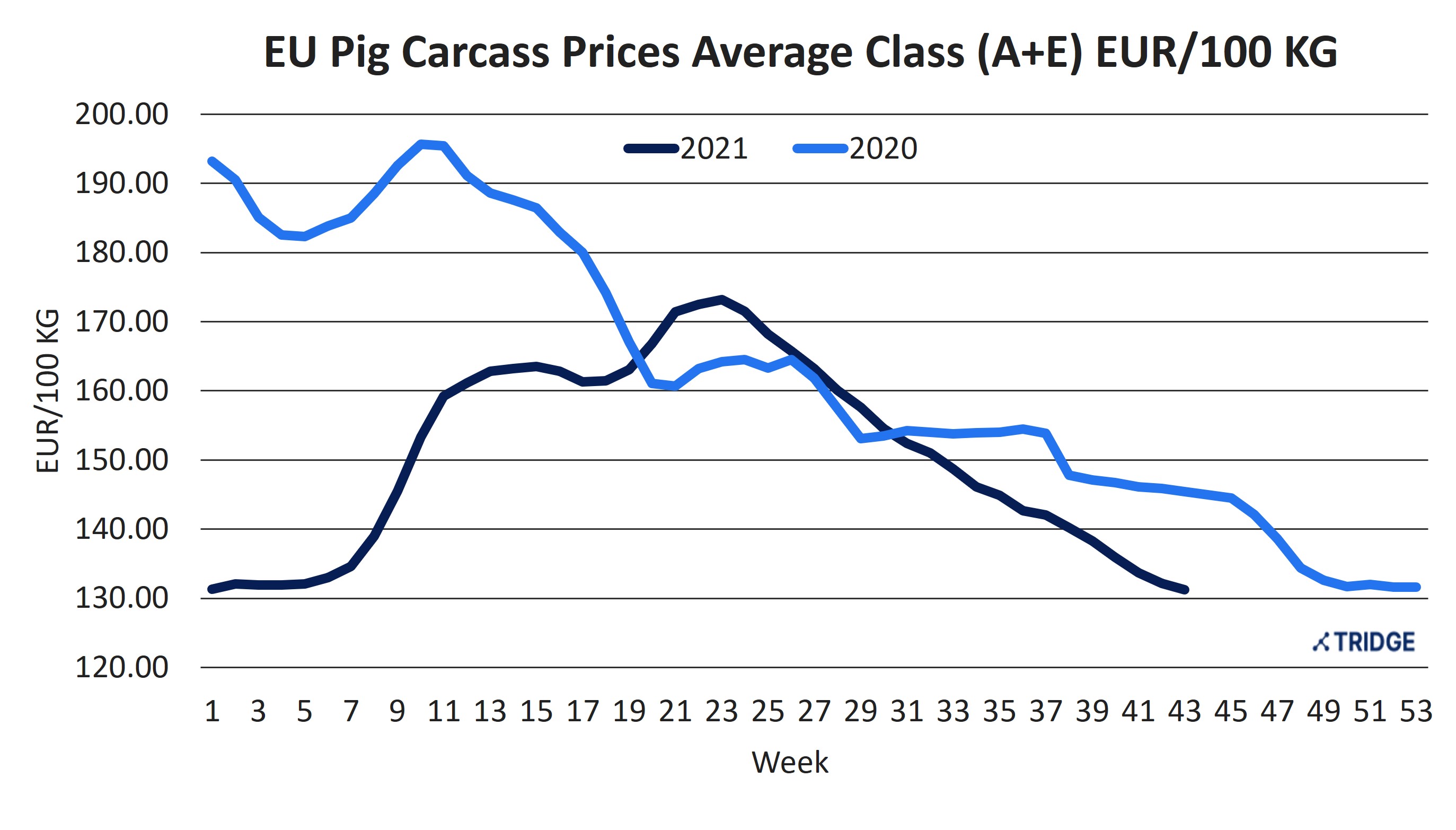High Supply and Low Prices of EU Pigmeat - Production Slowdown Awaits

Low prices and high supply makes a bitter cocktail for EU pigmeat producers
EU pork producers are finding themselves in a tough situation as production surplus is imminent but demands are plunging, not to mention increasing feed costs, the oversupply of pork resulting from falling demand from China and the HoReCa sector, is driving the prices in EU down. China’s demand has been falling in 2021 as domestic production regained strength, whereas Covid-19 restrictions continue to inhibit the demand for products aimed for the out-of-home food market.
EU prices of Average (S+E) were 132.1 EUR (USD 153.24) in week 42 of 2021, which is a decrease of more than 30% from the 2021 peak price in June and a decrease of 9.4% compared to week 42 in 2020.

For 2021, the slaughtering statistics show substantial production increases in the leading pig meat producing countries of the EU, with Germany being the exception.

Source: DG AGRI DASHBOARD: PIGMEAT Last update: 03/11/2021
The production has been on the rise due to European producers seeking to take advantage of the shortage of stock on the Chinese market, which led to high prices in 2020. The supply gap created by Germany on export markets has been covered by other EU member states. whereas cheap German pork has flooded the EU market. Yet, Germany’s production has declined in 2021 due to the 2020 outbreak of ASF.
If overproduction causing lower prices was not enough, producers also had to grapple with higher cost of feeds resulting from global harvest volumes of wheat and maize failing to meet expectations. On Oct. 28th. 2021, the price for wheat was 335/MT, up by 38% compared to the same time last year, whereas the barley price was USD 306/MT, up by 32%.
All these factors are expected to slow down pork production as profit margins for EU producers are on a decade low. However, the low prices of EU pigmeat does provide a comparative advantage on the international market.
Exports to China on decline in 2021
EU exports to China from Jan-Aug 2021 fell compared to the same period in 2020.

Source: Agri-food Data Portal, DG AGRI
The drop in 2021 exports to China is due to the recovery of domestic production in China following a short-term reduction in stocks brought about by the impacts of ASF outbreaks in 2020 along with upgrades of sow herds. Other EU export destinations such as Japan also had a decrease in export partly brought about by restrictions in food services prior to the Olympic Games in the summer of 2021.
The EU pork export industry is highly dependent on the ASF situation within the EU, and the domestic consumption and developments in the foreign markets. Further precautionary measures in production, culling of herds and import bans from foreign markets poses a serious threat to the industry.
Not only did the Chinese demand drop in 2021 but also the per capita consumption in the EU has fallen. Whereas the per capita consumption in 2017 was 34 kg/year in 2017, it is expected to land at 32.4 kg/year in 2021, representing a -4.71% fall .The European Commission estimates the consumption per capita will fall a further -1.3% in 2022, indicating that the domestic consumers are not likely to come to farmer’s rescue.
Lastly, the developments on the market of the world’s largest pigmeat importer, China, will be a deciding factor for the profitability for EU producers. In 2022, the Chinese import is forecasted to increase by 6% year-on-year. Read more on the expectations of the Chinese pork market in our Market Analysis “Global Pork Meat Trade is likely to be driven by China’s Growing Demand in 2022”.
During 2021, part of the volumes previously destined for the Chinese market have been diverted to other markets such as the Philippines, Vietnam and South Korea. ASF outbreaks in the Philippines and Vietnam presented the EU exporters with new market opportunities in 2021 and EU exporters are now diverting their produce to these markets.

Source: Agri-food Data Portal, DG AGRI
Sources
Tridge Analysis: Global Pork Meat Trade is likely to be driven by China’s Growing Demand in 2022
European Commission Short Term Outlook Autumn 2021
European Commission Short Term Outlook Autumn 2021 - statistical annex
EU pig meat market facing increased production with decreased demand
European Commission's Pigmeat Dashboard 03.11.2021






